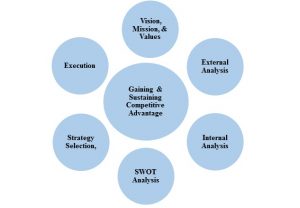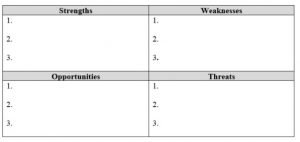4 Introduction to Business Strategy
Learning Objectives
The purpose of this chapter is to:
1) Give you a basic understanding of strategic management.
2) Introduce you to how a firm’s strategic planning process ties the planning, execution, and monitoring of the steps necessary for an organization to meet its goals and objectives.
What is Strategy?
An Internet search for the definition of strategy yields almost three billion hits. Which is correct? Michael Porter, a Harvard Business School professor respected for his work on strategy wrote “Strategy is the creation of a unique and valuable position, involving a different set of activities” (Porter, 1996, pg.1). Porter (1980), in a more succinct manner, stated that competitive strategy was the blueprint for how a business would compete in the marketplace, including its goals and objectives, In other words, strategy is the schematic, the framework for how an organization will operate. An organization’s strategy guides every aspect of how the firm conducts business. Marketing plans, sales processes, capital investments, expansion strategies, even the hiring of new employees are guided by the organization’s strategy. This is true whether you work for a non-profit, a family owned business, a public corporation, or a multinational operating in several countries.
Strategy is Challenging
Strategy can be complicated and confusing. Far too many people running all sorts of organizations confuse strategy with operations. According to Porter (1996), many leaders tend to confuse operational effectiveness with strategy. Operational effectiveness (i.e., becoming more efficient), quality control, outsourcing certain activities, lean management, Six Sigma, or any management tool utilized to become a better, more efficient operation is not strategy. All these are activities that can be copied by competitors. Every organization wants to become more efficient and most will seek out industry best practices to emulate. Strategy is not about being the best company or the most efficient operation. Strategy is about being different. Strategy is about choosing a different set of activities that deliver a unique mix of value (Porter, 1996). Think of a family member or friend who works for a company and ask yourself “why would a consumer spend their hard-earned money on your friend or family member’s product or service when they have a choice?” Another reason strategy is so difficult for so many is that they confuse strategy with objectives. A sales department leader may state that their strategy next year is to grow sales by 10%. Their marketing counterpart may remark that their strategy is to introduce two new products next fiscal year. Or, your CFO could state that “our financial strategy next year is to increase operational profit by 5%.” These are not strategies; they are objectives. Objectives flow from the organization’s strategic direction.
A.G. Lafley, former CEO of Proctor & Gamble, maintains that an additional reason why so many fail when it comes to strategy is that people don’t like to make hard choices. There are consequences when we make choices so it’s easier to focus on things you know, like operations, or simply do what you’ve always done. However, Lafley maintains that strategy is about making five difficult choices:
- What is your winning aspiration? Rather than define the organization’s mission and vision statements as a fuzzy, abstract picture of the future, translate the abstract into a more clearly delineated winning aspiration.
- Where will you play? Which market? Which segment? Which customers? No organization can be all things to all customers. This is one of the most challenging decisions an organization must face. Too many firms fail to make the tough choices about where they have a clear competitive advantage and end up squandering precious resources in markets that fail to deliver adequate results.
- How will I win? When thinking about how you will win, go back to the question “why would a consumer spend their hard-earned money on my product when they have a choice?” What makes your product or service unique? Why would a customer prefer your product over another? The answer is your competitive advantage. According to Porter (1996), competitive advantage is what makes a firm’s product or service preferable to a customer’s other options.
- What capabilities must be in place? Successful organizations have what are referred to as core competencies. Core competencies are the strengths and capabilities that enable an organization to tie its where-to-play and how-to-win decisions together and differentiate its products or services from its competitors. Core capabilities and competencies will vary from company to company depending on the industry in which they compete and the products or services they offer. Innovation, for example, is one of Apple’s core competencies. Product choice, price, and service are hallmarks of Amazon’s core competencies. Google’s online search engine has enabled the company to distance itself from its competitors with this dominant core competency.
- What management systems are required? To support an organization’s strategic direction, the entire operation must be aligned with the strategy. Production must be able to meet projected sales. Marketing plans must coordinate with product launches and new sales campaigns. Customer service operations must align with sales and financial goals. The right measurements to evaluate the results and take corrective action, if necessary, must be in place. In other words, strategic management is a system-wide process that involves, and ties, the entire operation together (Lafley, Martin, & Riel, 2013).
McKinsey consultants Bradley and Dawson (2013) summed it up well by noting that strategy is about the need to diagnose. Where are you today? What is your view of the future and what are your options to create value? Finally, you’ve got to select a strategy among your different alternatives.
A Brief History of Strategy
The concept of strategy can be traced to its roots in military history. The term “strategy” comes from the Greek word stratego which means “a general.” Military leaders since the dawn of time plotted moves to defeat their enemy, so, the thought of strategy as the planning and execution of tactics used in military campaigns evolved over time. For our purposes, the concept of business strategy began to develop in earnest in the 1950s and 60s as firms began to think about budgets and financial objectives beyond their current fiscal year. Ansoff’s (1965) book Corporate Strategy is considered by many to be among the first publications that spelled out a model of strategic planning from which decisions and directions could be determined. Chief among Ansoff’s concept of strategic thinking was the idea of gap analysis: where are you today, where do you wish to be, and what steps and tasks will take you there? Thoughts we are familiar with today but were unique at the time. In subsequent decades, strategic management thinkers including Peter Drucker who developed the concept of management by objective (MBO), Michael Porter with his contributions on how to compete, Henry Mintzberg who challenged the concept of strategic planning because so many plans failed to deliver, and Peter Senge with his approach to systems thinking added considerable weight to the need for not just strategic thinking but for strategic management.
The Strategic Planning Process

Wayne Gretzky is considered to be among the all-time great hockey players. Gretzky stated that much of his success while on the ice was because he skated to where the hockey puck was going to be, not where it had been. That simple analogy captures the goal of the strategic planning process. Long-term sustainable success is not necessarily where you are today; it is where you want to be in the future. The strategic planning process is the tool organizations use to plot their course toward a brighter future. Just as there are numerous definitions of strategy, there are several iterations about what the strategic planning process should look like. Downs (2017) noted that today organizations could choose from a number of strategic planning processes. These choices vary from a basic strategic planning model, the issue-based model, the alignment model, the scenario model, and the organic planning model. All this means is that there is no perfect system. The strategic planning process model presented below is based on the concepts of strategic thinkers including Porter (1980), Drucker (2008), and Bossidy and Charan (2002).

Let’s review each of the steps necessary to develop a high-quality strategic plan:
- Vision, mission, and values: These are the foundations of a strategic plan. A company’s vision statement envisions the future by creating a mental image of the desired future position of the organization, where it wants to be. The firm’s mission statement is more about “how” the vision will be achieved. Values are the core principles that guide the company. Let’s use Google as an example. Google’s vision is “to provide access to the world’s information in one click.” Their mission statement is “to organize the world’s information and make it universally accessible and useful” (Thompson, 2019). According to Brooks (2018) Google has ten corporate values among which are 1) follow the user and all else will follow; 2) it’s best to do one thing really, really, well; democracy on the web works; you can be serious without a suit; and great just isn’t good enough. Clearly defined values help guide a company and attract people who share those values and fit with the company’s culture.
- External analysis: The external analysis, sometimes referred to as the environmental analysis, is a deep dive that examines the industry in which the company competes. Here is a brief review of the more commonly used external analysis tools:
- o PESTEL analysis: PESTEL is an acronym for the process of examining the macro external forces that could impact an organization. Elements of a PESTEL analysis include: P – What political factors might affect the company? E – The economic factors that could impact the economy and the firm’s performance. S – What social factors or trends might be of importance to the organization? T – Are there technological factors that could affect the industry, the market in which it competes, or even an individual organization? E – Environmental factors such as geographic location, pollution, recycling, renewable energy, air and water pollution, and climate change which might affect the firm. L – Legal factors play an ever-increasing role in a company’s operations and must be reviewed to assess both short and long-term impact.
- o Porter’s (1980) Five Factor model is a tool used to analyze the market potential of varying industries. It examines five perspectives critical to a firm’s success within that industry: the power of suppliers, power of buyers, power of substitutes, the threat of new market entrants, all of which point to the intensity of the competition.
- o Competitive benchmarking is the part of the external process that entails a steely-eyed look at how your firm’s products or services stack up against your main competitors.
- o From the external analysis, a firm’s opportunities and threats are identified.
- Internal analysis: This part of the process is where an organization examines its internal resources. Tools for the job include:
- o The value chain analysis examines the firm’s primary and secondary activities. Primary activities are actions that add value directly to the company’s product or service offerings. These include sales and marketing, customer service, inbound and outbound logistics and its internal operations. Secondary activities are support functions necessary to support direct activities and include the organizations human resource practices, procurement processes, finance, and its technology.
- o The resource based analysis is a tool used to review a firm’s internal resources to determine if they can be capitalized on to achieve a competitive advantage. Those resources must be tested to determine if they are valuable, rare, non-imitable, and non-substitutable. Only those resources that fulfill all four criteria can meet the benchmark as a source of competitive advantage. A firm’s resources can be both tangible and intangible, and these are the building blocks of the organization’s capabilities.
- o The outcome of the internal analysis will result in identifying the firm’s strengths and weaknesses.
- SWOT Analysis: The SWOT analysis is a procedural method of looking at how an organization’s internal strengths and external opportunities can be utilized to accomplish its goals and objectives while seeking to minimize its internal weaknesses and external threats. The firm’s strengths and weaknesses (factors within the control of the organization) were identified through its internal analysis while its opportunities and threats (factors out of the organization’s direct control) were determined through the external analysis. The essential objective of conducting a SWOT analysis is to understand and evaluate all the factors involved in the operation of the enterprise. It is a critical step in the strategic management process. The SWOT matrix allows the firm to visualize its internal capabilities and external market factors.
SWOT Matrix

Once the SWOT matrix is complete and in prioritized order, the organization’s leaders should consider the following questions:
- How can the firm’s internal strengths be utilized to take advantage of an external opportunity?
- How can the firm’s internal strengths be used to minimize or mitigate an external threat?
- These moves are considered strengths based offensive choices upon which the firm can choose to capitalize.
- How can the firm reduce or eliminate an internal weakness to minimize an external threat?
- How can the firm beef up and internal weakness to take advantage of an external opportunity?
- These moves are considered defensive based choices the firm might choose to exercise.
- Strategy Selection: Once the SWOT matrix is complete, the critical next step in the strategic planning process is to determine which strategy the organization should pursue. Three generic strategies were developed by Porter (1980) that have become widely used as a starting point when considering a strategic direction. A differentiation strategy, often referred to as value-added, is when a firm has a product or service with unique features that customers will find better and distinctive from competitors’ offerings. The critical aspect of the differentiation strategy is the firm can charge higher prices while keeping its costs in line with the competition. The result is increased profitability. The cost-leadership strategy is when the firm offers products or services with the same value as its competitors while delivering those products or services at a lower cost. The focus strategy is a choice a business makes to concentrate on particular niche markets. The organization must still decide whether its niche strategy will be differentiation based or cost based. There is no one correct strategy for a business or a specific industry. The decisive factor must be the determination of which strategy will maximize the economic value created by the product or service. Two steps remain in the strategy selection process:
- 1) Once a firm determines its generic strategy based on its SWOT analysis outcome, it must select a narrower, more focused approach to the market in which it plays. Pearce (1982) identified 12 grand strategic options from which a firm could choose. Three of these grand strategies are widely popular and used around the globe. They include the concentration strategy which is when the firm strives to grow the use of its products or services in its present markets; market development which is when the business seeks to sell products it currently manufacturers in new markets; and product development which is when it moves to create new products for its current markets.
- 2) Once the organization selects a grand strategy, the next step is to develop goals and objectives. A critical element when establishing goals and objectives is to ensure that each has a specific metric so performance to goal can be measured. The acronym SMART refers to the five elements of a goal to make it actionable. The goal must be Specific, Measureable, Attainable, Relevant and Time bound. In other words, it can be accurately measured. If a goal or objective cannot be measured, it cannot be managed.
- Execution: According to Doniger (2019), just 10% of senior-level executives from global organizations stated that their organization managed to accomplish their complete list of strategic initiatives. Others estimate strategic initiative failure rates that range from 50% upward. Bossidy and Chran (2002) maintain that while faulty strategy is often to blame, more often than not, it is a failure to execute. An Economist Intelligence Unit Report (“why good strategies fail,” 2013), sponsored by the Project Management Institute, stated that strategy implementation is perhaps even more important than the strategy itself. Winston Churchill, the famous British Prime Minister who led Great Britain through the ravages of World War II noted that “however beautiful the strategy, you should occasionally look at the results.”
Summary
Think of strategy as an organization’s GPS. When using your car’s GPS, you know where you are, and you enter the location to where you are headed. In a moment, the GPS plots the course and gives you driving options, the number of miles to travel, and estimated arrival time. When a business or an organization develops its strategy, it follows the strategic planning process that starts with where you are and ends with where you want to be in the future. While the strategic planning process takes longer and is more labor intensive than setting your automobiles GPS, the outcome is the same. Successfully executed, a strategic plan helps you arrive safely, on time, and with minimal hassle. Strategy is vital to an organization because it provides clear direction along with measurable goals.
Critical Thinking Questions
Explain why strategy is so difficult and challenging
Why is strategy so important to the long-term success of a business?
Think of a business with which you are unfamiliar. Which of the generic strategies do you think they should pursue?
How to Answer the Critical Thinking Questions
For each of these answers you should provide three elements.
- General Answer. Give a general response to what the question is asking, or make your argument to what the question is asking.
- Outside Resource. Provide a quotation from a source outside of this textbook. This can be an academic article, news story, or popular press. This should be something that supports your argument. Use the sandwich technique explained below and cite your source in APA in text and then a list of full text citations at the end of the homework assignment of all three sources used.
- Personal Story. Provide a personal story that illustrates the point as well. This should be a personal experience you had, and not a hypothetical. Talk about a time from your personal, professional, family, or school life. Use the sandwich technique for this as well, which is explained below.
Use the sandwich technique:
For the outside resource and the personal story you should use the sandwich technique. Good writing is not just about how to include these materials, but about how to make them flow into what you are saying and really support your argument. The sandwich technique allows us to do that. It goes like this:

Step 1: Provide a sentence that sets up your outside resource by answering who, what, when, or where this source is referring to.
Step 2: Provide the quoted material or story.
Step 3: Tell the reader why this is relevant to the argument you are making.
References
Ansoff, I. (1965). Corporate Strategy. In S. Crainer (Ed.). The Ultimate Business Library (pp. 174). West Sussex, UK: Capstone Publishing.
Bossidy, L., & Charan, R. (2002). Execution: The Discipline of Getting Things Done. New York: Crown Business
Bradley, C., & Dawson, A. (2013). The art of strategy. McKinsey & Company Quarterly. Retrieved from https://www.mckinsey.com/business-functions/strategy-and-corporate-finance/our-insights/the-art-of-strategy
Brooks, R. (2018). Workplace spotlight: What Google gets right about company culture. Peakton. Retrieved from https://peakon.com/us/blog/workplace-culture/google-company-culture/
Doniger, S. (2019). Most of your organization’s strategic initiatives fail. Medium.com. retrieved from https://medium.com/@sdoniger/most-of-your-organizations-strategic-initiatives-fail-b167922bf594
Downs, B. (2017). The 5 strategic planning models all executives should know. BBG (Business Benefits Group. Retrieved from https://www.bbgbroker.com/strategic-planning-models/
Drucker, P. F. (2008) Management – Revised Edition. New York: Collins Business.
Lafley, A.G., Martin, R., & Riel, J. (2013). A playbook for strategy. Rotman Magazine, 5-9. Retrieved from ttps://matthewemay.com/wp-content/uploads/2014/08/Play2Win-Roger1.pdf
Pearce II, J.A. (1982). Selecting among alternative grand strategies. California Management Review. (24) 3, pp. 23-31.
Porter, M.E. (1980). Competitive Strategy. New York: Free Press.
Porter, M.E. (1996). What is strategy? Harvard Business Review, November, December, 1996. Retrieved from file:///F:/Articles/HBRs%20Must%20Reads%20on%20Strategy.pdf
Thompson, A. (2019). Google’s mission statement and vision statement (an analysis). Panmore Institute. Retrieved from http://panmore.com/google-vision-statement-mission-statement
Why good strategies fail. Lessons for the C-suite. (2013). Retrieved from https://www.pmi.org/-/media/pmi/documents/public/pdf/learning/thought-leadership/why-good-strategies-fail-report.pdf?v=14e7a7f5-ac4c-4331-b1cf-be9e26a30d18

